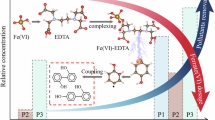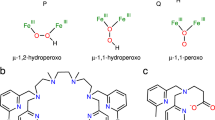Abstract
OUR knowledge as to the constitution of the coloured compound formed by the interaction of phenol with freshly prepared ferric chloride solution is very meagre. Brode and Wesp1 suggested that the violet-red colour is probably due to an ion of the type [Fe(OPh)6]−3; but they have not presented any evidence in its favour. We have studied the reaction by four different methods: thermometric, conductometric, absorption and transport measurements. Thermometric and conductometric titration curves of phenol with ferric chloride solutions show two breaks corresponding to Fe+3: phenol equal to 1 : 3 and 1 : 6; so these may be supposed to represent the formation of the compounds Fe(OPh)3 and H3[Fe(OPh)6]. By applying Job's method of continued variation, it is found that, for equimolecular solutions, the maxima in the optical density curve against the volume of one of the reactants appear at the point Fe+3: phenol equal to 1:3. The maxima of the curves are found to be independent of the wave-length (490 µ, 550 µ) and the concentration of the reactants used, and so are due to the formation of the compound Fe(OPh)3. Now the compound Fe(OPh)3 may also be formulated as Fe[Fe(OPh)6], in which case also the ratio of Fe+3: phenol is equal to 1:3. When ferric chloride – phenol solutions are shaken with non-polar organic solvents, the coloured compound is not found to be partitioned between the two liquid phases, and this supports the formulation of Fe(OPh)3 as Fe[Fe(OPh)6]. Finally, transport experiments by Duval's apparatus with solutions containing ferric chloride and phenol in the ratio 1:3 show that iron goes to the anode and thus give additional and direct evidence in favour of the formulation Fe[Fe(OPh)6].
This is a preview of subscription content, access via your institution
Access options
Subscribe to this journal
Receive 51 print issues and online access
$199.00 per year
only $3.90 per issue
Buy this article
- Purchase on SpringerLink
- Instant access to full article PDF
Prices may be subject to local taxes which are calculated during checkout
Similar content being viewed by others
References
Brode, W. R., and Wesp, E. F., J. Amer. Chem. Soc., 56, 1037 (1934).
Author information
Authors and Affiliations
Rights and permissions
About this article
Cite this article
BANERJEE, S., HALDAR, B. Constitution of Ferri-Phenol Complex in Solution. Nature 165, 1012 (1950). https://doi.org/10.1038/1651012b0
Issue date:
DOI: https://doi.org/10.1038/1651012b0
This article is cited by
-
Quantification of polyphenolic antioxidants and free radical scavengers in marine algae
Journal of Applied Phycology (2018)



